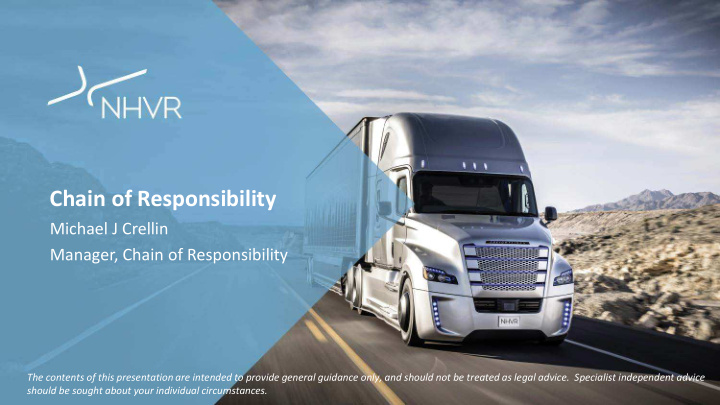



Chain of Responsibility Michael J Crellin Manager, Chain of Responsibility The contents of this presentation are intended to provide general guidance only, and should not be treated as legal advice. Specialist independent advice should be sought about your individual circumstances.
1999 2008 2014 2018 1995 Executive Officers Extended Liability Heavy Vehicle Primary Duty Small beginnings (Qld) & Representatives (Parties) National Law Reasonable Steps
Philosophy of CoR Chain of Responsibility (CoR) laws mean that any party in the chain who has influence over the transport activity is responsible for safety on the road.
Who is accountable under the HVNL? Scenario: A transport company is contracted by a customer to pick up a shipping container from the Port. Upon arrival, the sealed container is loaded onto the heavy vehicle and the driver is provided with a container weight declaration. On exiting the port the load is weighed and it exceeds mass requirements. Who is responsible?
What is coming – Primary Duties Primary Duty: A new direction in legislation
26C Primary duty - HVNL (1) Each party in the chain of responsibility for a heavy vehicle must ensure, so far as is reasonably practicable, the safety of the party’s transport activities relating to the vehicle. (2) Without limiting subsection (1), each party must , so far as is reasonably practicable— (a) eliminate public risks and, to the extent that is not reasonably practicable to eliminate public risks, minimise the public risks ; and (b) ensure the party’s conduct does not directly or indirectly cause or encourage— (i) the driver of the heavy vehicle to contravene this Law; or (ii) the driver of the heavy vehicle to exceed a speed limit applying to the driver; or (iii) another person, including another party in the chain of responsibility, to contravene this Law. (3) For subsection (2)(b), the party’s conduct includes, for example— (a) the party asking, directing or requiring another person to do, or not do, something; and (b) the party entering into a contract— (i) with another person for the other person to do, or not do, something; or (ii) that purports to annul, exclude, restrict or otherwise change the effect of this Law.
CoR: New Primary Duty Penalties • Category 3 – breaches safety duty • $50,000 Individual; $500,000 Corporation • Category 2 – risk of death/injury • $150,000 Individual; $1.5m Corporation • Category 1 – recklessness • 5 years imprisonment, $300,000 Individual • $3m Corporation
So far as reasonably practicable Reasonably practicable means something that is, or was at the time, reasonably able to be done to ensure health and safety, while taking into account and weighing up all relevant matters including: What the person The likelihood of The degree of knows about the the risk occurring harm risk Ways to remove Cost of modifying or reduce the risk is proportional to & whether they the risk are feasible
CoR: Practical impacts of Primary Duty Proactive and preventative outlook • Identify, assess and control risk • Recognise obligations and requirements as ‘risks’ • Manage requirements with best practice • Develop an assurance regime to ‘test effectiveness’ of system • 1. Demonstration of compliance 2. Monitoring, risk-based and interval audit regimes 3. Consultation with partners and sub-contractors
Controls and practices • Consider the entire system that ensures safety • Apply risk management processes to HV operations • Collaborate and engage with partners – support the freight operations • Integrate technology • Monitor operations and report continuously
The Future HVNL Scenario: Its late 2018, and word has spread that there are long queues at the Port and many of the heavy vehicles are waiting hours to load and unload. Every day the Port has an average of 20 heavy vehicles waiting to load/unload at any given time. There are no facilities for the drivers to wait in as they are required to progress in the queue. What is the approach now?
Three takeaways • CoR Laws will change for the road transport industry and supply chain in 2018 to focus on safety. • CoR Parties will need to proactively manage the risks involved in their transport operations. • Installing safety systems to reduce risks.
The Education & Awareness Program Phase 01 Phase 02 Phase 03 Phase 04 Awareness Installation Enhance Capability Convert design capability Increase knowledge and Build industry capability Enable continuous understanding of CoR, to installation and improvement through to design Safe Systems Risk and Safe Systems testing system review and assurance that address risk under effectiveness the Primary Duty practices (Co-Regulation Model)
Codes of Practice • Establishes standards and procedures for parties in the chain of responsibility to identify , analyse , evaluate and mitigate general risks associated with meeting obligations under the Heavy Vehicle National Law (HVNL).
Codes of Practice
Safety Management Systems The contents of this presentation are intended to provide general guidance only, and should not be treated as legal advice. Special st independent advice should be sought about your individual circumstances.
SMS Framework
Pillar 1 - Safety policy • Management commitment • Safety accountabilities • Appointment of key safety personnel • Documentation
Pillar 2 - Safety risk management Risk management allows you to: • identify risks • understand risks • make informed decisions
Pillar 3 - Safety assurance • Monitoring how the system operates • Measuring safety performance • Managing change In order to: • continually improve the system
Pillar 4 - Safety promotion An SMS must include: • education and processes for training personnel in safety-critical areas • effective two-way communication between managers and employees
Why are SMS important? Improves the safety performance Key benefits include: • Increased Safety • Informed Decisions • Reduced Costs • Defensible Position • Legal Responsibilities • Business Reputation.
Recommend
More recommend